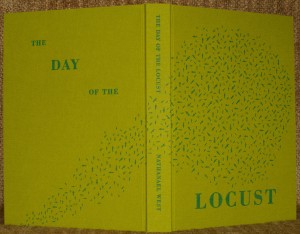 Let me just say right off that this was not my favorite novel. It could be because the subject matter isn’t of much interest to me. I’m not much of a movie or television watcher, so Hollywood’s film history doesn’t do anything for me. Of slightly more interest is the description of Hollywood as a physical place in time and of California as a place where listless people apparently came to die. I’ve always been one to wonder how a landscape has changed over time, probably from a lot of time spent staring out the car window at passing terrain. And I saw a lot of it as a “Navy brat” whose family moved every two years up and down the Eastern Seaboard. The past 25 years I’ve settled in Southern California, so some of the neighborhoods in the book are familiar even though obviously much changed through the years.
Let me just say right off that this was not my favorite novel. It could be because the subject matter isn’t of much interest to me. I’m not much of a movie or television watcher, so Hollywood’s film history doesn’t do anything for me. Of slightly more interest is the description of Hollywood as a physical place in time and of California as a place where listless people apparently came to die. I’ve always been one to wonder how a landscape has changed over time, probably from a lot of time spent staring out the car window at passing terrain. And I saw a lot of it as a “Navy brat” whose family moved every two years up and down the Eastern Seaboard. The past 25 years I’ve settled in Southern California, so some of the neighborhoods in the book are familiar even though obviously much changed through the years.
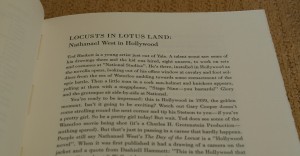 I definitely struggled a bit with West’s writing. Some sentences I had to read several times, thinking they could have used a good editor. Or maybe it was just dated or colloquial sentence structure. I’m not as bothered by that when I read much older literature. I even pointed out a couple of passages to one of the copy editors at the Press but they all were true to West’s published text.
I definitely struggled a bit with West’s writing. Some sentences I had to read several times, thinking they could have used a good editor. Or maybe it was just dated or colloquial sentence structure. I’m not as bothered by that when I read much older literature. I even pointed out a couple of passages to one of the copy editors at the Press but they all were true to West’s published text.
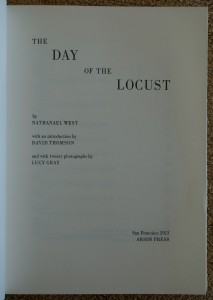 I can definitely see how a movie-buff would like this book much more than me, however. One of the best descriptive passages in the book occurs as Tod is moving through the movie studio lots. West does some of his best writing describing the sets, the actors and extras, and the controlled chaos that went on behind the scenes of some of the classic movies. Before computer animation made some things like big battles easier, whole battles had to be staged with real actors. And sometimes they went horribly wrong, as when the wrong side seemed to be winning in one of the engagements at the historic battle when they were filming the big-budget movie Waterloo. This miscalculation by the stage managers for the two sides was then compounded when they charged onto a set that was not yet ready for action, with catastrophic and comic results.
I can definitely see how a movie-buff would like this book much more than me, however. One of the best descriptive passages in the book occurs as Tod is moving through the movie studio lots. West does some of his best writing describing the sets, the actors and extras, and the controlled chaos that went on behind the scenes of some of the classic movies. Before computer animation made some things like big battles easier, whole battles had to be staged with real actors. And sometimes they went horribly wrong, as when the wrong side seemed to be winning in one of the engagements at the historic battle when they were filming the big-budget movie Waterloo. This miscalculation by the stage managers for the two sides was then compounded when they charged onto a set that was not yet ready for action, with catastrophic and comic results.
When he took time to flesh out a character, the reading got more enjoyable for me, even if it didn’t make me like any of the characters. In fact, I’m not sure I liked any of the characters much. But that was part of what West was trying to portray, the desperate and down-trodden people existing under the glitzy façade of Hollywood success and the glitz and glamour of the stars.
Faye is the femme fatale of the novel, and also the most developed after the protagonist Tod. Since she is the object of so many of the character’s desires, West spends a lot of time describing her, and some of these passages are the best
He had nothing to offer her, neither money nor looks, and she could only love a handsome man and would only let a wealthy man love her. Tod was a “good-hearted man”, and she liked “good-hearted men”, but only as friends. She wasn’t hard-boiled. It was just that she put love on a special plane, where a man without money or looks couldn’t move.
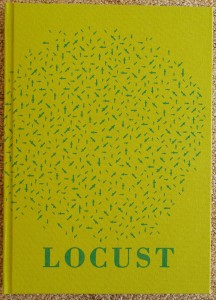 Her invitation wasn’t to pleasure, but to struggle, hard and sharp, closer to murder than to love. If you threw yourself on her, it would be like throwing yourself from the parapet of a skyscraper. You would do it with a scream. You couldn’t expect to rise again. Your teeth would be driven into your skull like nails into a pine board and your back would be broken. You wouldn’t even have time to sweat or close your eyes.
Her invitation wasn’t to pleasure, but to struggle, hard and sharp, closer to murder than to love. If you threw yourself on her, it would be like throwing yourself from the parapet of a skyscraper. You would do it with a scream. You couldn’t expect to rise again. Your teeth would be driven into your skull like nails into a pine board and your back would be broken. You wouldn’t even have time to sweat or close your eyes.
None of them really heard her. They were all too busy watching her smile, laugh, shiver, whisper, grow indignant, cross and uncross her legs, stick out her tongue, widen and narrow her eyes, toss her head so that her platinum hair splashed against the red plush of the chair back. The strange thing about her gestures and expressions was that they didn’t really illustrate what she was saying. They were almost pure. It was as though her body recognized how foolish her words were and tried to excite her hearers into being uncritical. It worked that night; no one even thought of laughing at her. The only move they made was to narrow their circle about her.
I also liked his characterization of actors, such as when Tod was observing the sick Harry
He also noticed that Harry, like many actors, had very little back or top to his head. It was almost all face, like a mask, with deep furrows between the eyes, across the forehead, and on either side of the nose and mouth, plowed there by years of broad grinning and heavy frowning. Because of them, he could never express anything either subtly or exactly. They wouldn’t permit degrees of feeling, only the furthest degree.
And as for Tod himself, that “very complicated young man with a whole set of personalities”, I can’t say I’d wish him on any woman. With all the “rape culture” in our society today, the inherent misogyny in a passage where a character is thinking “If only he had the courage to wait for her some night and hit her with a bottle and rape her” is hard to take.
In the end, West accomplished what he set out to do. He shows the darker side of celebrity and pop culture without trying to sugar coat or romanticize it. He reminds us that for every Gary Cooper, there was an angry and agitated mob of desperate drifters, wanna-be’s, and extras. People on the make and people that just came to California to die.
Despite the fact that this wasn’t my favorite novel to read, the physical book will always have an honored place in my library. Why? My daughter joined the press a short time before the work began on this book and thus her name appears on an Arion Press colophon for the first time. That’s a pretty proud moment for a book-loving father who was able to pass his love of literature, books, and reading on to his daughter.
From a design perspective, the book is a flat back binding similar to other recent books like Paris Walks, The Sundial, and South of Heaven. I like how the title is split between the back and front covers. At first I assumed that the design was also meant to represent a swarm of locust, and maybe that was indeed the intent. But after reading the novel, I tend 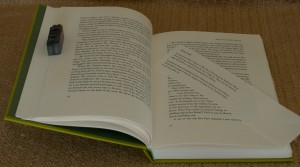 to think of it as an aerial view of the mob at the end of the book surging through the barriers. As always, the paper used by the press for this edition is wonderful, providing a tactile and olfactory treat for the reader. This time they used mouldmade Magnani Velata.
to think of it as an aerial view of the mob at the end of the book surging through the barriers. As always, the paper used by the press for this edition is wonderful, providing a tactile and olfactory treat for the reader. This time they used mouldmade Magnani Velata.
As I mentioned before, as I read through this edition there were a few places where I paused and thought there was a mistake. While most of them were just West’s writing style, it does turn out that there a couple of lines left out of the text. So the press quickly issued an errata slip to keep in the book and make the correction. To my knowledge, this is the first time that the Arion Press has had to issue an erratum announcement for a book. Considering this is the 97th publication of the press, I suppose that is not such a bad record.
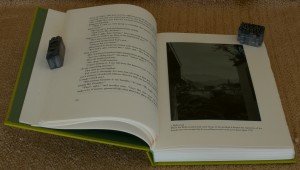 Illustrations always seem to be a flash point among book lovers. There is always much debate about whether a particular illustrator is right for a book, or if the medium of illustration is right for the book. Indeed, even what the basic job of the illustrator is can be a source of endless debate. Is the illustrator there to recreate scenes from the book faithfully? How much liberty can one take? Etc., etc. In the case of the Arion Press edition, we know that Ed Ruscha was originally slated for the illustrations. But then, due
Illustrations always seem to be a flash point among book lovers. There is always much debate about whether a particular illustrator is right for a book, or if the medium of illustration is right for the book. Indeed, even what the basic job of the illustrator is can be a source of endless debate. Is the illustrator there to recreate scenes from the book faithfully? How much liberty can one take? Etc., etc. In the case of the Arion Press edition, we know that Ed Ruscha was originally slated for the illustrations. But then, due 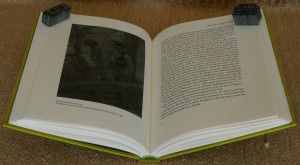 no doubt to the vicissitudes of the publishing world, we have Lucy Gray’s photographs instead. No doubt the book would have been quite different under Ruscha’s treatment. My film buff friends do not seem impressed with Gray’s illustrations but I think she’s done a good job of capturing some of the creepiness of the characters. It probably helps that I have not seen any film treatment of the novel and thus had no pre-concieved notion of what the characters should look like.
no doubt to the vicissitudes of the publishing world, we have Lucy Gray’s photographs instead. No doubt the book would have been quite different under Ruscha’s treatment. My film buff friends do not seem impressed with Gray’s illustrations but I think she’s done a good job of capturing some of the creepiness of the characters. It probably helps that I have not seen any film treatment of the novel and thus had no pre-concieved notion of what the characters should look like.
The Day of the Locust is another example of a book that probably would never have a place in my library except for the fact that it was part of the subscription series. Sometimes those books that would never otherwise be read are a revelation to me. Sometimes they are special for other reasons, like the colophon in this case. But it’s always a pleasure to have another fine edition from the Arion Press in the library.
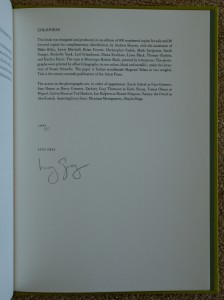 AVAILABILITY: As the latest book in the subscription series for 2013, this book is available from the Arion Press website. The edition is limited to 400 copies for sale, signed by the photographer.
AVAILABILITY: As the latest book in the subscription series for 2013, this book is available from the Arion Press website. The edition is limited to 400 copies for sale, signed by the photographer.
